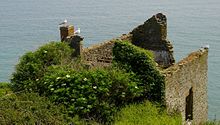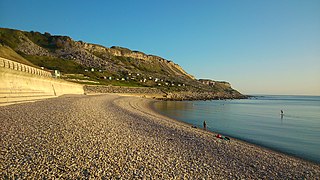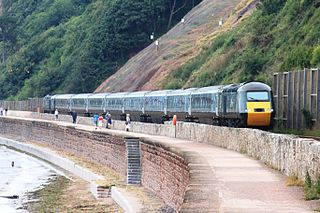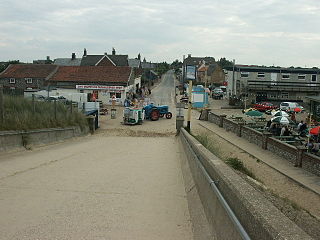
Hallsands is a village and beach in south Devon, England, in a precarious position between cliffs and the sea, between Beesands to the north and Start Point to the south.

Hallsands is a village and beach in south Devon, England, in a precarious position between cliffs and the sea, between Beesands to the north and Start Point to the south.
The early history of Hallsands is unknown, but a chapel has existed there since at least 1506. The village was at a cave known as Poke Hole, and probably was not inhabited before 1600. [1] The village grew in size during the 18th and 19th centuries, and by 1891 it had 37 houses, a spring, a public house called the London Inn, and a population of 159. Most residents of Hallsands at that time depended on fishing for a living, particularly crab fishing on the nearby Skerries Bank.


In the 1890s, following a scheme proposed by Sir John Jackson, it was decided to expand the naval dockyard at Keyham, near Plymouth, and dredging began offshore from Hallsands to provide sand and gravel for its construction. Soon, up to 1,600 tons of material was being removed each day, and the level of the beach began to drop, much to the alarm of local residents. [2] The Board of Trade agreed to establish a local inquiry in response to protests from villagers, who feared that the dredging might destabilise the beach and thereby threaten the village. The inquiry found that the activity was not likely to pose a significant threat to the village, so dredging continued. [3]
By 1900, however, the level of the beach had started to fall. In 1900's autumn storms, part of the sea wall was washed away. In November 1900, villagers petitioned their Member of Parliament complaining of damage to their houses, and in March 1901 Kingsbridge Rural District Council wrote to the Board of Trade complaining of damage to the road. In September 1901 a new Board of Trade inspector concluded that further severe storms could cause serious damage and recommended that dredging be stopped. On 8 January 1902 the dredging licence was revoked. During 1902 the level of the beach recovered, but 1902 winter brought more storms and damage.
On 26 January 1917, a combination of easterly gales and exceptionally high tides breached Hallsands' defences, and by the end of that year only one house remained habitable. [4] The villagers' fight for compensation took seven years.
According to Pathe News newsreel footage from 1960, the last inhabitant of the village was Mrs. Elizabeth Prettejohn. [5]

The site of the old village at South Hallsands is closed off to the public, although South Hams District Council has built a viewing platform, which is accessed from the track below Prospect House Apartments (formerly Trout's Hotel). Two houses remained intact and were used as holiday homes.
In May 2012, the access road, viewing platform and the two houses were affected by a 200 tonne landslide, leading to the houses being evacuated and the affected area cordoned off. [6]
The beach at North Hallsands (also known as "Greenstraight") is the only one at Hallsands. The beach below the old village no longer exists, having been removed by the previous dredging and repeated storms. In 2016 the beach at North Hallsands was reported to have been washed away by storms, leaving only a peat underlay which contains the remnants of a petrified forest. However, this is part of a regular natural cycle which occurs every few years, as are the more frequent episodes where the shingle from North Hallsands is removed by the scouring action of the local sea currents, deposited at other parts of the bay and then eventually returned by the same process.
There are no plans to restore the sea defences at North Hallsands or protect the few houses at possible risk as South Hams Council has had a policy of no intervention since 2002. [7]
In 1903, English writer John Masefield published "Ballads", a collection of poems including "Hall Sands". The introductory part of the poem alerted that "the land in which the village stands is beginning to slip and settle".
The 1964 film The System directed by Michael Winner, starring Oliver Reed and Jane Merrow filmed scenes with the two actors at the ruins.
In 1993, the poet William Oxley published 'The Hallsands Tragedy', a series of poems about Hallsands and its fate.
In 2002, dramatist Julian Garner wrote the play Silent Engine set in the ruins of Hallsands about a couple whose marriage is as wrecked as the village following the death of their young child. It was presented on a short tour and at the Edinburgh Festival by Pentabus Theatre Company performed by Cathy Owen and Robin Pirongs. A second production was staged at Cheltenham Playhouse by Ad Hoc Theatre Co in May 2010 performed by Rachel Prudden and Paul Scott.
In 2003 BBC Radio 4 first broadcast the play, Death Of A Village, by writer David Gooderson. The play addresses the events of 1917, emphasizing that the underlying cause was not that year's combination of severe storms in itself but the dredging of the beach for gravel by government contractors, which had been taking place for several decades despite many warnings of its dangers. The play was based on contemporary records and looks at the events leading up to the great storm, and the village's subsequent fight for compensation.
In 2006, the opera company 'Streetwise Opera' commissioned a new opera, Whirlwind, based on the story of Hallsands. It was written by Will Todd and Ben Dunwell and premièred at The Sage Gateshead, on 24 October 2006.
On 15 November 2010, Damon Albarn revealed on BBC Radio 4's Today Programme that Hallsands is the beach which inspired him and Jamie Hewlett to produce the Gorillaz Plastic Beach LP.
In the 2016 Julien Temple-directed documentary on Keith Richards, Keith Richards - The Origin of the Species, Richards told how he used to holiday as a child with his family at Hallsands. [8]
In 2017, British prog-rock band 'Kaprekar's Constant' released a 14-minute epic in their album 'Fate outsmarts desire' about the Hallsands story. In the same year, artist Frances Gynn, musicians Lona Kozik, and Sam Richards collaborated on a web-project titled Hallsands arts. [9]
In 2019, Devon folk duo 'Harbottle & Jonas' released their latest album 'The Sea is My Brother', which has the track 'Hall Sands', which is about the events in 1917.

Coastal erosion is the loss or displacement of land, or the long-term removal of sediment and rocks along the coastline due to the action of waves, currents, tides, wind-driven water, waterborne ice, or other impacts of storms. The landward retreat of the shoreline can be measured and described over a temporal scale of tides, seasons, and other short-term cyclic processes. Coastal erosion may be caused by hydraulic action, abrasion, impact and corrosion by wind and water, and other forces, natural or unnatural.

Borth is a village and seaside resort in Ceredigion, Mid Wales; it is located 7 miles (11 km) north of Aberystwyth, on the Ceredigion Coast Path. The community includes the settlement of Ynyslas and the population was 1,399 in 2011. From being largely Welsh-speaking, the village has become anglicised; over 54 per cent of its residents were born in England. According to both the 1991 and 2001 censuses, 43 per cent of the residents of Borth were primarily Welsh-speakers.

South Hams is a local government district on the south coast of Devon, England. Its council is based in the town of Totnes, although the largest town is Ivybridge. The district also contains the towns of Dartmouth, Kingsbridge and Salcombe and numerous villages and surrounding rural areas.

Lynmouth is a village in Devon, England, on the northern edge of Exmoor. The village straddles the confluence of the West Lyn and East Lyn rivers, in a gorge 700 feet (210 m) below Lynton, which was the only place to expand to once Lynmouth became as built-up as possible. The villages are connected by the Lynton and Lynmouth Cliff Railway, which works two cable-connected cars by gravity, using water tanks.

Dawlish is a seaside resort town and civil parish in the Teignbridge district in Devon, England. It is located on the south coast of England at a distance of 12 miles (19 km) from the city of Exeter and a similar distance from the town of Torquay. The 2011 Census population was recorded at 11,312, rising to 13,355 in a 2019 estimate. Dawlish had grown in the 18th century from a small fishing port into a seaside resort, as had its near neighbour, Teignmouth, in the 19th century.

Clovelly is a privately owned harbour village in the Torridge district of Devon, England. The settlement and surrounding land belongs to John Rous who inherited it from his mother in 1983. He belongs to the Hamlyn family who have managed the village since 1738.

The 1953 North Sea flood was a major flood caused by a heavy storm surge that struck the Netherlands, north-west Belgium, England and Scotland. Most sea defences facing the surge were overwhelmed, resulting in extensive flooding.

Bacton is a village and civil parish in Norfolk, England. It is on the Norfolk coast, some 12 miles (20 km) south-east of Cromer, 25 miles (40 km) north-west of Great Yarmouth and 19 miles (30 km) north of Norwich. Besides the village of Bacton, the parish includes the nearby settlements of Bacton Green, Broomholm, Keswick and Pollard Street. It also includes Edingthorpe, which was added to Bacton civil parish under the County of Norfolk Review Order, 1935.

Slapton is a village and civil parish in the South Hams district of Devon, England. It is located near the A379 road between Kingsbridge and Dartmouth, and lies within the South Devon Area of Outstanding Natural Beauty (AONB). The nearby beach is Slapton Sands; despite its name, it is not a sandy beach but a shingle one.

Chesil Cove is a curved steep bank forming the south-east end of 29-kilometre (18 mi) Chesil Beach in Dorset, England. It is thus part of one of three large shingle structures in Britain, extending from West Bay to the Isle of Portland, the latter acting more firmly as a great barrier (groyne) which stops tidal action from washing the beach away and leads to the high depositions by wind and tide action forming the grand curved bank of this "cove". The "cove", bill and much of Chesil Beach give shelter from the prevailing winds and waves for much of Weymouth Bay, the town of Weymouth and the village of Chiswell. It forms part of the Jurassic Coast.

Kingsand and Cawsand are twin villages in southeast Cornwall, United Kingdom. The villages are situated on the Rame Peninsula and are in the parish of Maker-with-Rame.

The South Devon Railway sea wall is situated on the south coast of Devon in England. A footpath runs alongside the railway between Dawlish Warren and Dawlish, then another footpath forms a continuation to the sea front promenade at Teignmouth. Both of these form part of the South West Coast Path.

Torcross is a seaside village in the South Hams district of south Devon in England. It stands at grid reference SX822420 at the southern end of Slapton Sands, a narrow strip of land and shingle beach which separates the freshwater lake of Slapton Ley from Start Bay and carries the A379 coastal road north to Dartmouth.
Ella Trout was a fisherwoman from Hallsands, Devon, England, who helped rescue nine men from a sinking ship. Ella was one of four sisters, the others being Patience, Clara and Edith.

Brenish is a small village situated on the west coast of the Isle of Lewis, which is part of the Outer Hebrides of Scotland. Brenish is within the parish of Uig. The name of the village is sometimes spelt Breanish, however maps normally refer to Brenish.

Sea Palling, also historically spelled Pawling and Pauling, is a village and civil parish covering 11.05 km2 (4.27 sq mi) in the English county of Norfolk. The village is 19.6 miles (31.5 km) south-east of Cromer, 19.6 miles (31.5 km) north-east of Norwich and 140 miles (230 km) north-east of London. The village lies 4 mi (6.4 km) east of the A149 between Kings Lynn and Great Yarmouth. The nearest railway station is at North Walsham for the Bittern Line, which runs between Sheringham, Cromer, and Norwich.
The Lynmouth Flood occurred on the night of the 15–16 August 1952, principally affecting the village of Lynmouth, in north Devon. A storm with heavy rainfall, combined with already saturated soil and flood debris, led to the flooding of the village and a total loss of 34 lives.

Cyclone Anne was a European windstorm which caused €75 million in damage across western Europe in early January 2014, followed days later by Cyclone Christina.

The 2013–2014 United Kingdom winter floods saw areas of Ireland and the United Kingdom inundated following severe storms. The south of England saw heavy rainfalls associated with these storms which caused widespread flooding, power cuts and major disruptions to transport. Economically, the worst affected areas were Somerset, Devon, Dorset and Cornwall in the south west and the Thames Valley in the south east.

From December 2013 onwards the Somerset Levels suffered severe flooding as part of the wider 2013–2014 Atlantic winter storms in Europe and subsequent 2013–2014 United Kingdom winter floods. The Somerset Levels, or the Somerset Levels and Moors as they are less commonly but more correctly known, is a coastal plain and wetland area of central Somerset, in South West England, running south from the Mendip Hills to the Blackdown Hills.